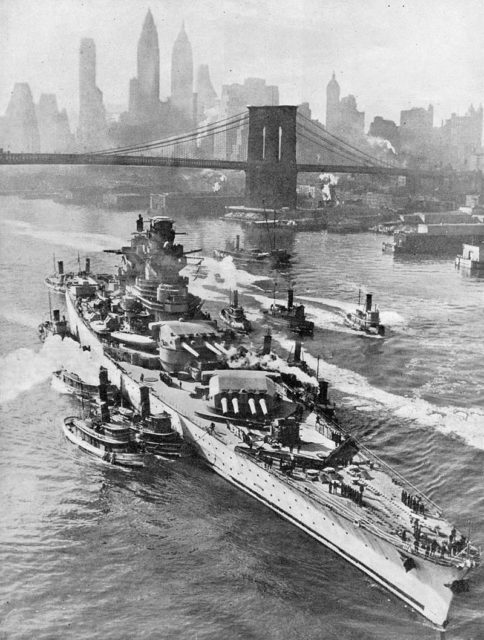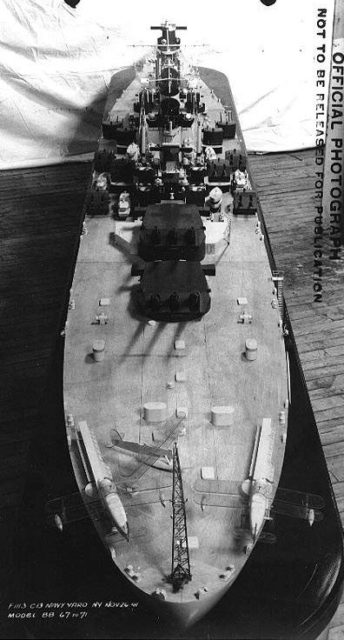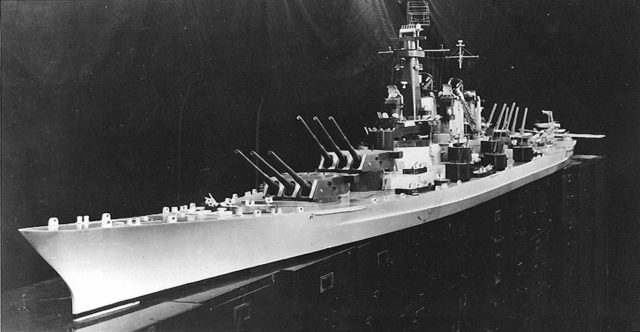I was surfing around and ran across this article on the Internet. I have blogged about Battleships in the past, like I have stated, funny that an Army guy likes Navy ships. I figured this would be a good article for my blog collection on Battleships.
Artist’s impression of the Montana class Battleship
Myth #1: The Montana class Ignored the Panama Canal Restrictions
The Montana class was the first battleship designed to ignore the restrictions imposed by the Panama Canal locks.The Truth
One of the common misconceptions about the Montana class battleships is that they were to ignore the Panama canal restrictions. This is only partially true. In realty the US was planning on expanding the Panama Canal locks to 140ft. Construction was meant to be completed around the same time that the Montana ships would come into service. The ability to quickly send ships through the Panama Canal was an advantage that the US was unwilling to part with. The fact that the canal locks were going to be enlarged was likely a big reason why the US Navy finally designed the Montana class.While the Montana might have ignored the Panama Canal restrictions, they were bound by another. A little known fact is that the US Navy placed almost as much importance on being able to travel underneath the Brooklyn bridge as they did the Panama Canal. The height of the bridge at low tide was an important design consideration for ship design. This was because the New York Naval yard was one of the largest naval bases at the time. It was also one of the largest naval repair facilities available. The Navy needed all ships to be able to travel to that yard and the Brooklyn bridge was the largest obstacle along the way.

Myth #2: The Montana was Designed to Counter the Yamato
Another big misconception about the Montana class was they were “Yamato killers”. Yes, They were the only other battleship capable of engaging the Yamato on equal terms. Also, the Yamato was known to the US Navy at the time of design. However, what the US Navy thought they knew about the Yamato was a far cry from what it actually was.
The Truth
It would be a long time before the US had a grasp of the Yamato’s capabilities. When design started in 1938, the Yamato was believed to be a standard battleship. Over the course of the war, new evidence slowly allowed the navy to better understand what it was that it was up against. A breakdown of discoveries about the Yamato can be broken down into the following:- In 1936, a US received reports that Japan was building ships up to 55,000 tons.
- In 1938, reports stated that Japan was building two 16″ heavy battleships with two more on the way.
- It wasn’t until 1944 that the US found that the Yamato carried 18″ guns.
- It wasn’t until late 1944/1945 that the US navy finally had a grasp of the true specifications of the Yamato.
So if the Montana wasn’t designed to counter the Yamato, why was it so large? It is largely because the ship was designed to withstand the firepower of its own guns. The 16″/50 cannon when coupled with the “super heavy” 2700lb shell could have been the finest battleship gun ever to see service. At long ranges, its penetration power was almost that of the larger Japanese18.1″ shell. Due to this similarity, the fact that the Montana was so well protected was really a happy accident.
The other contributing factor was that the US wanted a battleship more powerful than anything its adversaries was likely to use. A ship more powerful than the vessels preceding it, the Bismark class of Germany, the Nagato class of Japan, and so on. An almost impractically large ship to dominate all others. In some ways, the US didn’t believe anyone else would construct such a large ship. Unknown to the US, Japan had the exact same thoughts when designing the Yamato.
Myth #3: The Montana was basically a larger Iowa Class Battleship

The Truth
The belief in the connection between the Iowa and Montana classes likely stems from their similar appearance and use of the same main armament. However, examination of their design features shows two very different ships for two different roles.Armor
Armoring is the largest difference between the two classes. The Iowa class ships used an internal armored belt inherited from the proceeding South Dakota class. This brought the armored belt inside the hull and was done as a weight saving measure. However, shells striking this belt first penetrated the outer hull. This had the unwelcome effect of potentially flooding the void space between hull and belt for shots that hit at or below the waterline. The Montana design didn’t have to follow weight restrictions and so reverted back to a traditional external belt where the armor was on the outside of the hull. This ensured that potential damage was outside of the hull and that watertight integrity would remain intact. Unlike the Iowa, the Montana was protected from its own guns. This armoring style reflects the design philosophies behind the two ships. The Iowa was meant to be a fast interceptor to guard against cruisers and fast battleships. The Montana class was designed to participate with the main battle line and engage in furious gunnery duels with multiple battleships.Speed
After armor, speed shows another sizable difference between the classes. The Iowas were designed to be high-speed 32-knot battleships to act as the protection to the carrier fleet. While designers considered making the Montana class faster, they decided that firepower and armor were more important. Thus, the Montana was limited to a speed of 28 knots like the North Carolina and South Dakota classes. Not fast enough to escort carriers, but fast enough to operate in the battle line.Overall, the Montana was a vastly different warship compared to the Iowa class. The design reflects the role that they were intended for, a heavily armed and armored warship capable of taking on anything else that it might encounter.
Final Thoughts
The Montana class battleships would have been one of the most powerful dreadnoughts ever to be launched, rivaled only by the Yamato class battleships. However, like the Yamato, the tiger tank, or many other of the “wonder weapons” created during the Second World War, a certain aura of myth has been built around them. They weren’t ultimate weapons conjured up to single-handedly win the war, just simple units designed to fill a role particular role in warfare. Unfortunately for the Montana class, the role of the battleship in warfare was in its twilight phase. They arrived too little too late.

Wow. Thanks so much for the history lesson. I shared it. Love your posts. I always learn a lot. You are a most appreciated brainiac.
ReplyDeleteGood post! You got the big points most miss. Well done, sir!!!
ReplyDeleteNever knew such a class was intended. Navy, it seems, caught on to the changing nature of naval warfare before such ships were built.
ReplyDelete